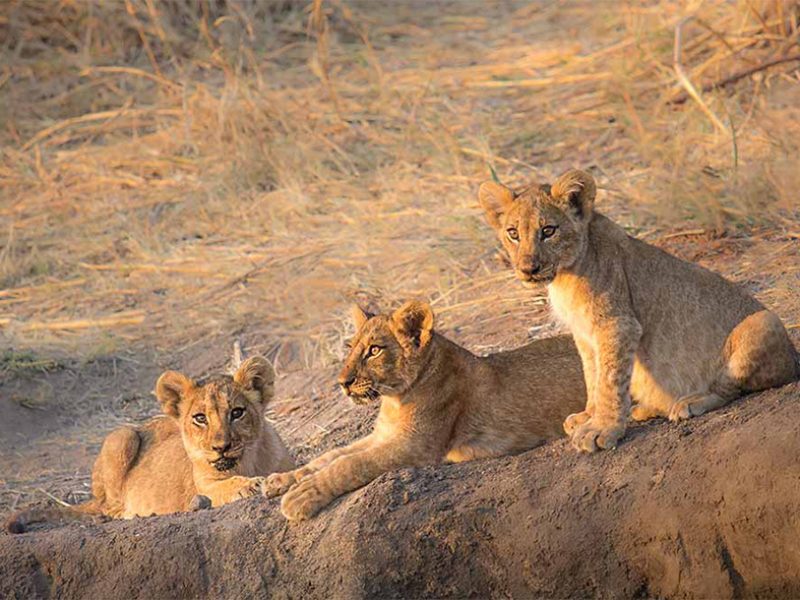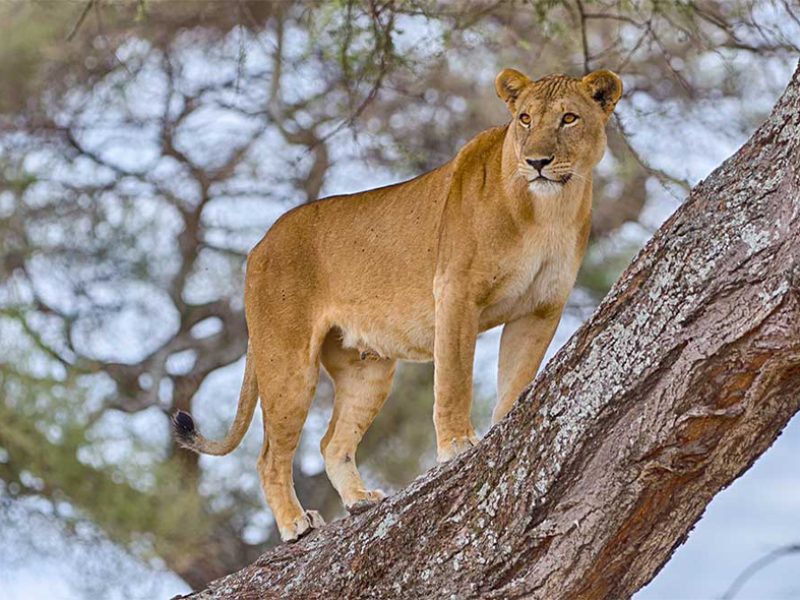Tarangire National Park
Tarangire National Park
A large herd of buffaloes make their way to the shallow waters of the Tarangire River as elephants scratch their backs on the iconic Baobab trees and a lioness stretches sitting on an Acacia tree, letting her gaze wander across the swamps. Diverse and scenic landscapes, a high density of wildlife, yet still one of the lesser-known national parks in Tanzania – that’s Tarangire National Park.
Tarangire is conveniently situated along the way to the more famous Serengeti and Ngorongoro Crater. But it is a popular park and excellent safari destination in its own right – and so much more than just a stopover to break up the journey!
The vegetation within the park is extremely diversified and includes open grasslands, savannah, Baobab trees and thick acacia bush as well as palm trees and swamps full of tall elephant grass in the south.
What to expect
Most visitors enter from the north and spend an afternoon exploring the area around the Tarangire River, the lifeline and main source of drinking water in the park. Elephants, buffaloes, antelopes, and zebras greet travellers and offer a classic safari experience.
To those who stay more than just one night, Tarangire invites you to the more remote Southern section of the park: The Silale Swamp is one of the main features here, stretching across 70 square kilometres (3,044 square miles). It is not only a favourite for elephants, munching on the lush greens, but also big cats. With a bit of luck, you can observe tree-climbing lions on a Tarangire safari, snoozing in the cool shade while keeping a close eye on antelopes and zebras trot by.
A few selected accommodations in the Southern section of the park even offer walking safaris. An exciting activity, exploring the home of the wild on foot. Walking safaris are permitted only in a few specific areas in Tanzania’s national parks.
Which animals can you see in Tarangire National Park?
Tarangire National Park has a healthy population of creatures both big and small. The park has plenty of resident animals although some tend to migrate depending on the time of year. The most commonly seen animals on a Tarangire safari are elephants, giraffes, impalas, warthogs, zebras, wildebeests, dwarf mongoose and ostriches. However, lions can also be seen, as well as leopards and on some rare occasions even wild hunting dogs have been spotted. The park is also home to 550 species of birds, the greater and lesser Kudus as well as oryx antelopes.
During the months of June to September the park witnesses a small migration during which thousands of wildebeests and zebras head to the park for better grazing grounds. Elephants and other animals follow suit to gather along the Tarangire River, the only permanent water source in the park. It has been claimed, that up to 2000 elephants reside in the park during these months with some coming as far as from Amboseli National Park in Kenya.
Predators
Cats are also very much present in the park and lions can be found soaking up the sun on the riverbanks, whereas leopards are sometimes spotted resting in the baobab trees. Cheetahs are around but usually like to stay hidden from unsuspecting prey.
African wild dogs have been seen towards the southern part of the park and seeing that the numbers of these efficient hunters are dropping, spotting them can be a real treat.
Birds
But it is not only mammals you need to look out for while in Tarangire National Park as the park also boasts with 550 different bird species. The most commonly seen birds include yellow collared lovebirds, red billed hornbills, southern ground hornbills, lilac breasted rollers, ostriches, many kinds of raptors as well as several kinds of water birds just to name a few.
Vegetation and landscapes
Tarangire National Park with its baobab crested landscape is scenically one of the most beautiful parks in Tanzania. Baobab trees tower above the savannah. These age-old trees play a vital role in the ecosystem as they act as homes for bees, birds and bats. In addition, they provide nourishing fruit and supply animals such elephants with indirect water especially during the drier months.
Until the mid-1990s, one of these ancient trees was used as hiding place by illegal poachers. The hollow inside of the giant tree served as the perfect cover from rangers on patrol. Once inside, they were nowhere to be seen. Here, they would dry and store illegally hunted wildebeest, buffalo and zebra meat. Luckily, the rangers eventually put an end to their illegal activities. Today, you can visit the Poachers Hide and step inside the Baobab tree.
Tarangire River
The Tarangire River flows all year round and is an important lifeline for many of its residents, especially during the dry season. The river flows into Lake Burunge situated in the northwest. On the other hand, the south of the park is dominated by marsh land, which is impassable in the wet season but tends to dry out completely in the dry season.



Best time to go to Tarangire National Park
Tarangire looks distinctly different in the rainy and in the dry season. During the rainy season the grass is tall, the river is flowing, and the vegetation is fresh; wildlife disperse throughout the park as there are many sources of water to sustain them. This, coupled with dense vegetation, means wildlife sightings are not always easy, but bird lovers will enjoy the sight of many migratory birds in the park. The peak of the rainy season is usually between March and May.
The best time to visit Tarangire National Park is arguably the dry season between June to October and early November. Wildlife density is high since many animals from surrounding areas migrate to the area’s main water source, the Tarangire River. Scarce vegetation means, wildlife can easily be spotted. As a general rule of thumb, rates are lower in the rainy season and availability at accommodations may be a challenge for short-notice bookings during the dry season.

